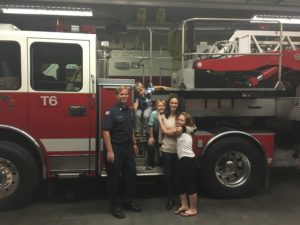Community Risk Reduction Influencers

There are many individuals who make up the homes in our communities. Some examples include parents, children, teenagers, grandparents, room mates, friends, etc. Community Risk Reduction involves changing behaviors of individuals, homes, and communities to improve safety. Think about your Fire Prevention and Community Risk Reduction programs. Who is your target audience? Often times we only teach the primary grades of education. Even within that group, we often only focus on K-2nd grade. Are our programs for these age groups high quality like those created by Fire-Ed or are they simply a “show-n-tell”? How many of those children are brining the safety messages home and making lasting changes from our efforts? How many programs do we have for adults or teens? Sadly, not very many.
“Community Risk Reduction involves changing behaviors of individuals, homes, and communities to improve safety.”
Community Risk Reduction Influencers
Who holds the most influence in the home? It’s easy to say the parents, but is that necessarily true? Here are some examples of where teens have input in decisions. (Source)
- Apparel for the teen to wear (96% of teens having some degree of influence)
- Personal care products for the teen (93%)
- Footwear for the teen (93%)
- Which fast-food restaurants to go to (95%)
- Types of out-of-home entertainment/sports/recreation to attend or do (93%)
- Where to shop for clothes for the teen (90%)
- Which sit-down restaurants to go to (88%)
- Where to shop for footwear for the teen (88%)
These are statistics directly related to the teen. How about we look at some influence they have for the family.
- Where to shop for in-home entertainment and technology devices (50%)
- Regarding which vehicle to purchase or lease (45%)
- Where parents go on vacations without their children (44%)
Harnessing the Teen Passion

These numbers show the impact teens have on the home. Let’s think about recycling. There are some passionate teens on this subject. My daughter has a friend which recycling is like her religion. Teens can take active rolls in the home, almost forcing their recycling beliefs on the rest of the house. Would recycling be as important in these homes without these teens? Probably not.
Is there a way we can harness the passion teenagers have, focusing it to change the risk in the home? What if we could influence these “Social Warriors” to take up fire prevention, drowning prevention, emergency preparedness, or electrical safety the same way they do recycling, the poor, or individual rights? Why isn’t Community Risk Reduction, an equally worthy social issue, one of their hot buttons? Why aren’t these teens leading fire escape drills at home, installing smoke alarms for their neighbors, maintaining evacuation routes in the community, demonstrating at city hall to fund that community disaster preparedness program? Maybe because we haven’t marketed the “Social Cause” to them.
Marketing Community Risk Reduction to Teens
Why are teens so passionate about social issues? Because they are marketed to by actors, artists, and politicians where it matters to them, in music, video, and social media. How many of your Community Risk Reduction processes and programs include marketing to teens through music, video, and social media? Before you say, “We are on Facebook, Twitter, Instagram, etc.” and “We have multiple PSA’s addressing these issues.” Are the messages meant for teens? Are the actors teens? Is the message in teen language? Are the spokespeople relate-able or even known by your teen audience? Are teens your target audience? If not, you are probably not marketing to one of the biggest decision makers in the home.

Teens and Devices
Walk into a room of teens and what will almost everyone of them have? A cell phone. When you walk in that same room, it is a safe bet that at that moment over half of them are looking at said cell phone. The others just put their cell phone in their pocket or are reaching to retrieve their cell phone. It has become a normal extension of their body and soul. It is not uncommon for them to text each other when they are only a few feet away. The “Virtual” world is the world they live in. This “Virtual” world is so closely aligned with their “Real” world the lines are almost nonexistent.
Virtual Community Risk Reduction and Teens
There are many ways to reach teens “Virtually.” The most readily available, is through their cell phone. Try this, go to one of your local high schools. Ask to meet with the video club, photography club, drama, social media, band, etc. Challenge them, as a project, to make videos, memes (Do you know what a meme is?), and social media posts regarding Community Risk Reduction issues in your community that relate to them, in their own way. Let them interview the fire chief, fire marshal, or rookie firefighter (They are close in age and may be more relate-able than a gray haired middle aged man, sorry truth hurts. 😡 Come to think of it, what if we had them interview a young male and female rookie or Fire Prevention Professional. That may be pushing it, wink, wink, 😀 )
Make it a contest among classes or schools. You will be amazed at what they can do. I bet they will even do it faster than your department currently is and with better quality. You may even organize groups to canvas their neighborhoods showing the Vision 20/20 safety videos and performing safety surveys utilizing Virtual CRR on their phones to the “old folks” who don’t know how to use electronics, who knows! (I hope you have a sense of humor 😯 )
“It doesn’t make sense to hire smart people and then tell them what to do; we hire smart people to tell us what to do.” Steve Jobs
Virtual CRR is a perfect platform to reach teens. It can be customized with the videos created by the teen groups or whatever messages you want. It can be pushed out on whatever social media platform teens are using this week as well as next week. Those memes they make can go perfectly on the survey and the safety report they receive. Teens will want to share this because it relates to them and was created by them.

Teens, the New Community Risk Reduction Evangelists
Sorry Matt Hinds-Aldrich, the “CRR Evangelist.” I’m borrowing your title. I hope you don’t mind. With the influence these teens have in the home and the community, they too can become “CRR Evangelists.” I just saw a great quote from Steve Jobs, “It doesn’t make sense to hire smart people and then tell them what to do; we hire smart people to tell us what to do.” Hire them to get your message out in their way. This could be the start of a true CRR awakening.
 Brent Faulkner is a founding member of MBIntel and now serves as its CEO. He has 20 years of experience in the fire service. During this time, he has responded to numerous emergency situations including structure fires, wildland fires, hazardous materials responses, emergency medical situations, and numerous types of rescues. In addition, he has served on a Type 1 Hazardous Materials Response Team for 14 years.
Brent Faulkner is a founding member of MBIntel and now serves as its CEO. He has 20 years of experience in the fire service. During this time, he has responded to numerous emergency situations including structure fires, wildland fires, hazardous materials responses, emergency medical situations, and numerous types of rescues. In addition, he has served on a Type 1 Hazardous Materials Response Team for 14 years.
Brent had a defining moment in his career which, as a result, lead him to MBIntel and his passion for Community Risk Reduction. He lead a team in critical infrastructure protection at a recognized Department of Homeland Security (DHS) Terrorism Fusion Center. This team was responsible for increasing the safety of critical infrastructure as it relates to terrorism, general security, and natural disasters. He also specializes in emergency preparedness for homeowners and businesses. He has a master’s degree in management, a bachelor’s degree in occupational studies, an associate’s degree in hazardous materials response, and another in fire science.
